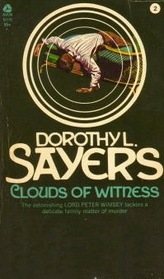Helpful Score: 1
An entertaining, if wordy, mystery featuring Lord Peter Wimsey. Very British. This book is copyrighted in 1927, and printed in 1966. If you are a fan of traditional British mysteries, this is for you.
Clouds of Witness was published in 1926 and is Sayers' second novel in her series featuring Lord Peter Wimsey. In this one, Wimsey's brother, The Duke of Denver, is accused of murdering Captain Denis Cathcart, the fiancé of their sister Lady Mary. Mary who was trying to leave the house at 3 am finds Denver kneeling over Cathcart's body who was shot in the chest. Denver is arrested after it is found that his revolver was used to kill Cathcart and after he admits quarreling with him when he finds out Cathcart was cheating at cards. Wimsey arrives to investigate along with his friend from Scotland Yard, Inspector Parker, who is assigned to the case. So is Denver guilty? If not, who had motive to kill Cathcart?
I enjoyed this novel and felt it was a step up from the first in the series, Whose Body? which I read just prior to this one. There was quite a bit of humor in the first part of the novel even though the family was in dire straits with the murder hanging over the Duke's head. Sayers also fleshed out the family of Wimsey along with all their eccentricities and foibles. There were also a lot of red herrings and coincidences in the story which made it a fun ride to try and figure out who may have killed Cathcart. The characters were also portrayed very well including some of the supporting characters. This was especially true for a most unpleasant local farmer named Grimethorpe who had a beautiful wife who he was very jealous of. He suspected she had been seeing someone on the side and at one point when Peter first meets him Peter asks about his daughter saying "I thought the charmin' little girl might be yours." Grimethorpe replies, "And if I thought she weren't, I'd strangle the bitch and her mother together. What hast got to say to that?" Of course, Wimsey was taken aback by this remark but didn't let it phase him.
There was also a lot of adventure for Wimsey and his man, Bunker, in this one trying to find and interview witnesses. At one point they are lost in a bog in the fog at night and Wimsey almost didn't make it out. The story also takes the characters to other locales including Paris and New York. Wimsey almost doesn't make it back from New York when the airplane he is in gets engine trouble due to bad weather. (I was somewhat surprised that Wimsey could fly across the Atlantic as part of this novel since it took place in the early 1920s. Lindbergh's solo flight was not until 1927 but there were earlier flights dating back to 1919.) And I was also quite surprised by the novel's ending and how Cathcart was killed. I look forward to reading more in this series.
I enjoyed this novel and felt it was a step up from the first in the series, Whose Body? which I read just prior to this one. There was quite a bit of humor in the first part of the novel even though the family was in dire straits with the murder hanging over the Duke's head. Sayers also fleshed out the family of Wimsey along with all their eccentricities and foibles. There were also a lot of red herrings and coincidences in the story which made it a fun ride to try and figure out who may have killed Cathcart. The characters were also portrayed very well including some of the supporting characters. This was especially true for a most unpleasant local farmer named Grimethorpe who had a beautiful wife who he was very jealous of. He suspected she had been seeing someone on the side and at one point when Peter first meets him Peter asks about his daughter saying "I thought the charmin' little girl might be yours." Grimethorpe replies, "And if I thought she weren't, I'd strangle the bitch and her mother together. What hast got to say to that?" Of course, Wimsey was taken aback by this remark but didn't let it phase him.
There was also a lot of adventure for Wimsey and his man, Bunker, in this one trying to find and interview witnesses. At one point they are lost in a bog in the fog at night and Wimsey almost didn't make it out. The story also takes the characters to other locales including Paris and New York. Wimsey almost doesn't make it back from New York when the airplane he is in gets engine trouble due to bad weather. (I was somewhat surprised that Wimsey could fly across the Atlantic as part of this novel since it took place in the early 1920s. Lindbergh's solo flight was not until 1927 but there were earlier flights dating back to 1919.) And I was also quite surprised by the novel's ending and how Cathcart was killed. I look forward to reading more in this series.




